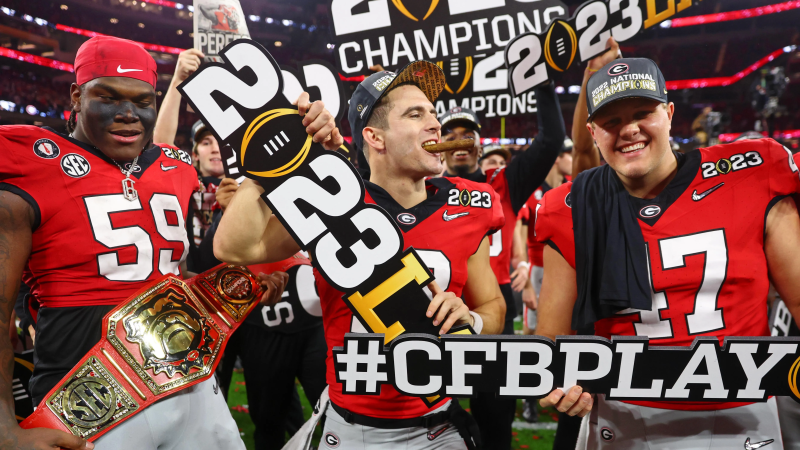What does the NCAA proposal to pay players mean for college athletics?
NCAA president Charlie Baker unveiled a proposal Tuesday that could alter the landscape of college sports.
In a letter to Division I schools, Baker outlined the key tenets of − and reasoning for − a proposed shift in governance that would effectively enable big-money athletic departments to directly compensate athletes, by allowing each to create an "enhanced educational trust fund" for them.
The proposal would also allow those same schools, likely the upper echelon of the Football Bowl Subdivision, to branch off and make their own rules surrounding roster size, transfers and name, image and likeness (NIL), among other issues.
There's still much to be learned about the NCAA's proposal, including details of how it would be implemented. But here's a quick look at why Tuesday's letter is a significant step, what we know about it and what it means for the future of college sports.
So why does this matter, exactly?
The big takeaway is this: The NCAA is opening the door for big-money schools to branch off from everyone else, and directly pay their athletes.
Simply proposing this in the first place is a radical step forward for an organization that has clung to the idea of amateurism for decades now, even as college sports boomed into a multi billion-dollar enterprise and coaches started pocketing $10 million per year. It's not quite the move toward classifying athletes as employees that some advocates have been seeking, but it would be money going directly from schools to athletes.
The creation of a "Rich Schools" subdivision is also important here, because it would mean that your Alabamas and Michigans could start playing by different rules than your Louisiana-Monroes. In fairness, this shift has felt inevitable for a while now. But it would allow Rich Schools to create their own policies around issues like helmet communication in football without needing input or approval from schools with less revenue.
OPINION:NCAA's new proposal could help ensure its survival if Congress gets on board
How much money are we talking about here?
Baker writes in his letter that any school in this new Rich Schools subdivision should be required to "invest at least $30,000 per year into an enhanced educational trust fund for at least half of the institution’s eligible student-athletes," within the framework of Title IX.
Assuming about 525 athletes per school, which is the average in the Southeastern Conference, that works out to a minimum of about $7.88 million per year − which would be peanuts for schools like Alabama and Michigan.
This is one part of the proposal, however, where there are still many details to be worked out. And it's worth noting that, while Baker appears to be setting the floor for how much money must be invested, his proposal says nothing about a ceiling.
Why is the NCAA making a proposal at all?
By dragging its feet on issues like NIL and athlete pay, the NCAA all but invited outside entities like Congress and the courts to meddle in its business. And this proposal appears to be, at least in part, an attempt to ward off some of those outside efforts − and perhaps diffuse some of the tension that's been brewing in Division I, between the haves and the have nots.
Would this affect championships and conferences?
No. Under Baker's proposal, schools could choose whether or not to opt-in to the Rich Schools subdivision. So it appears the setup for NCAA championships, including the NCAA men's and women's basketball tournaments, would remain the same. Ditto for conferences.
Could this mean that a Rich School could face a lesser-revenue school in March Madness? Yes. In fact, in theory, it means there could be Rich Schools and lesser-revenue schools in the same conference, unless the conference mandated entry for all of its members.
What does this mean for gender equity?
Baker's reference to Title IX, the federal gender-equity law, points to one huge ripple effect of this proposal: It could lead to more NIL money for women.
Under the current arrangement, many schools disburse NIL funds through tangential-but-technically-separate entities called collectives. And because those collectives are not under the umbrellas of their athletic departments, they are not subject to Title IX. As a result, as of this summer, about 95% of NIL money was going to male athletes, according to Jason Belzer, the co-founder of Student Athlete NIL, which oversees more than 30 collectives.
By effectively moving NIL in-house, Baker's proposal would ensure that schools have to divide the money more equitably, though it's unclear if they would have to be completely equal on a dollar-for-dollar basis.
What are the next steps?
As of now, Baker's proposal is simply that. And in his letter, he includes a link at which school personnel can provide feedback. Once finalized, the proposal − or, possibly, string of separate proposals − would still have to be formally voted upon by Division I governance panels, such as the board of directors and council.
Even if enacted, it probably wouldn't put an end to Congressional efforts to reshape the sport, or efforts in court and before the National Labor Relations Board to classify athletes as employees.
In short, Baker's proposal would be a seismic shift to college sports, particularly at the highest levels − but it wouldn't solve everything, nor prevent other significant changes to the model in other ways.
Contact Tom Schad at tschad@usatoday.com or on social media @Tom_Schad.

Disclaimer: The copyright of this article belongs to the original author. Reposting this article is solely for the purpose of information dissemination and does not constitute any investment advice. If there is any infringement, please contact us immediately. We will make corrections or deletions as necessary. Thank you.







